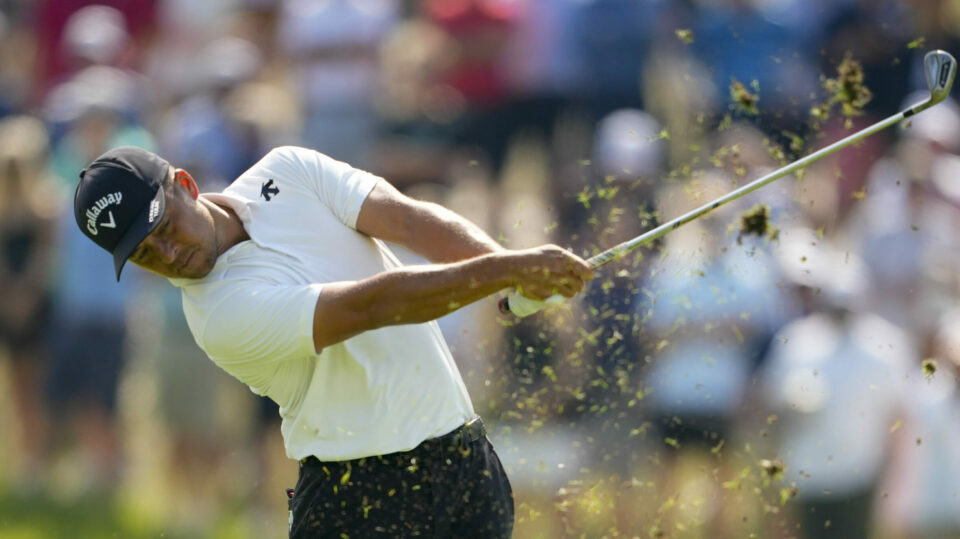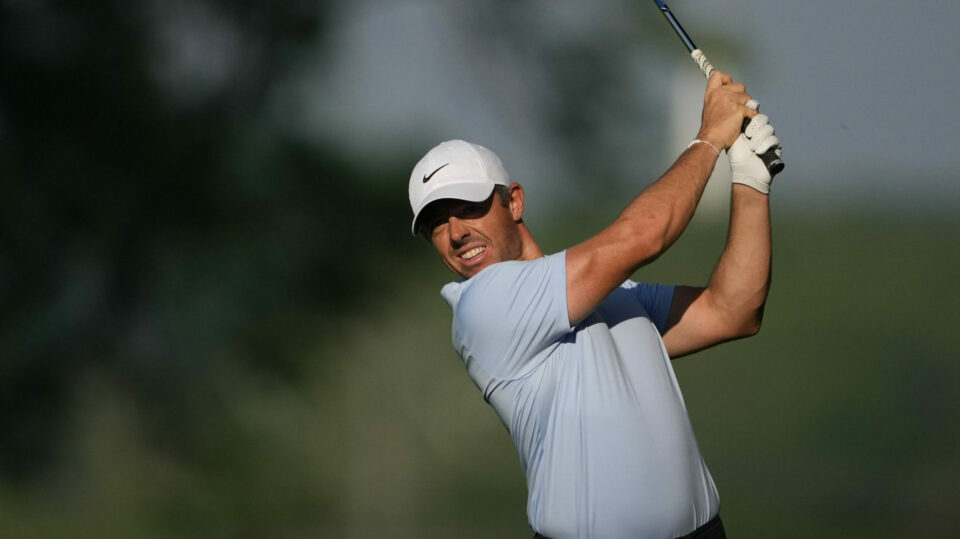This year's Masters will feature a new extended teeing area for the renowned 13th hole at Augusta National Golf Club.
In recent years the pivotal par 5 has become far less of a risky situation providing too easy an opportunity for a barrage of birdies and even eagles.
The game plan chosen by Augusta National is not simply relegated to extending the tee at the 13th. When Tiger Woods won his first Green Jacket in 1997 total yardage for the course was 6,925. For this year's event it will top off at 7,545.
In that same year of 1997, John Daly was the first golfer to break the 300-yard barrier in distance from the tee. Fast forward to 2022 and the lead player in that category was Cameron Champ at just over 321 yards.
During the 21-22 PGA Tour season, 99 players crossed the 300-yard mark. The implications are clear; securing success at the highest of levels means attaining maximum distance is paramount.
Keep in mind, when Daly led in 1997, the average tee shot distance was just under 268 yards. That number today is approximately 297.
Golf swings today at the elite level have incorporated two central aspects. They are more optimised and efficient. The science of hitting a golf ball for maximum distance has advanced noticeably since 1997. Go to any professional event of consequence and you'll see a distance-measuring device immediately near to where tour players are practicing.
Instruction now relies on videos in which teacher and student can monitor each and every movement. The choreographing of a golf swing follows the same precision and intensity as that of a high-level dancer. Quirky swings of the past have nearly been eliminated.
The overall athleticism of world class players has also improved dramatically. Comprehensive nutrition programmes are employed as well as physical fitness regimens.
When Woods set or tied 27 Masters records during his epic 1997 performance, it became clear to the brains trust at Augusta National they would need to put in motion a comprehensive game plan in order to keep the course relevant from being overwhelmed by future performances, not only from Woods, but others following in his path.
Other key holes at Augusta National have had additional yardage tacked on in order to balance out the incredible distances today's players are hitting tee shots.
It's important to point out Augusta National is able to mount the effort because it has the financial wherewithal to do so. The overall footprint of the property has been expanded and the club's leadership has been adamant it will take whatever steps are needed in order to preserve the design intent of co-founder Bobby Jones and architect Alister MacKenzie.
But not every golf club has available options for similar steps. In a number of instances, classically designed courses from the Golden Age of Architecture in the USA during the 1920s and 1930s have hit limits on expanding teeing areas.
A number of courses have now reached the point of obsolescence in terms of staging future championships.
In February 2020, the United States Golf Association (USGA) and the R&A detailed in a 102-page document how distance is a problem and is causing the sport to go in an unsustainable direction.
The issues go beyond simply the competitive balance. Golf is a game played outdoors and the time, attention and money it takes to prepare a playing field is no small matter of consequence.
The Distance Insight Report outlined critical concerns in the financial and environmental areas, among others. Sustaining the sport going forward will likely require meaningful reforms enacted.
The R&A and the @USGA have today released the Distance Insights report, the most comprehensive look at this issue in the game’s history.
Click here for more information👉 https://t.co/HBxsQwEtLB pic.twitter.com/q3hTvPDiog
— The R&A (@RandA) February 4, 2020
Golf courses consume plenty of water each day. According to the USGA all golf courses in the country use roughly 2 billion gallons of water. That figure represents just 0.5% of the total water drawn but the visuals for such usage have to reconcile with the growing realisation climate change is a reality and the need to be as prudent as possible with such a critical resource is front and centre. Golf has needs but the broader population vastly outnumber those passionate about the sport. In a public relations war, golf loses out.
It's been over two years since that report was made public and there is a strong possibility the two governing bodies will announce, at some point in 2023, remedies on the distance front. Whatever the proposed solutions are will undoubtedly not please everyone.
The USGA and R&A do not have any enforcement mechanism. Any rules announced are limited to the championships they administer.
Both governing bodies are in the persuasion business and its possible other key stakeholders in golf may not walk in lockstep with what both rule-making organisations see as the game plan going forward.
But the pathway golf is on now could have taken a far different turn.
The role of Augusta National Golf Club is not to be minimised. Yes, the club hosts the annual Masters event but the stature the club represents could have brought forward a different solution. Pushing a pause button then could very well have changed the direction the game is heading in now.
Rory gives his take on the Distance Insights Report ⬇️ pic.twitter.com/sgQQ4XzBlM
— Golf Channel (@GolfChannel) February 3, 2021
There's little question the USGA and R&A had past opportunities to combat the surge in clubs and ball technology that has spiked far beyond the equipment used previously.
Both bodies slept at the wheel when it was clear manufacturers were able to provide significant breakthroughs on the equipment side. Metal oversize heads with longer and lighter weight shafts using titanium and now carbon were combined with three-and-four-piece golf balls that aerodynamically go way beyond what the previous generation of golf balls flew.
The writing was on the wall. Golf, like the Roman Empire, was metaphorically burning and the USGA and R&A jointly played the role of Nero, unwittingly fiddling away crucial time.
The ascension of Woods showed clearly when you combine superb athleticism / elite golf skills and link that with advancements in club and ball technology, you get outcomes that overwhelm what used to be competitive golf courses and reduce them now to pitch and putt sideshows. Tiger proofing of courses was put into motion but its impact has been limited.
Given the negligence of the governing bodies for fear of being sued by the equipment companies, Augusta National could have taken a proactive stance and introduced a specific Masters golf ball.
Far-fetched you say.
Hardly.
The Masters tournament has universal respect and is held in awe. Players from around the globe fully comprehend the aura the event carries and the lasting glory that comes with winning a Green Jacket.
The other key stakeholders within golf are no less aware of the major role Augusta National plays. The club has taken important steps on other matters with the inclusion of the Women's Amateur held the week prior to the Masters. There's also the Drive, Chip and Putt event which Augusta National serves as host for the finals.
In the 1800s, the average drive with a feathery golf ball was 180-200 yards. But in 1836, Samuel Messieux hit the longest recorded drive with a feathery, launching it 361 yards; his distance was helped by a frozen ground which allowed his ball to roll for the record. #golf pic.twitter.com/tRWQaE1WXB
— Shanking Shots Historical Society (@ShankingShots) January 21, 2022
When it became apparent that equipment gains were fundamentally altering golf, with an over emphasis on distance, there was a window when a clear time out could have been instituted.
How?
A Masters golf ball could have been brought into being. Implementing such a draconian solution would have been precedent setting and a noticeable and necessary deviation from longstanding deference to the USGA and R&A.
The Masters could have simply laid down a new golf law. One stating that instead of having to increase hole yardages on a steady basis, a folly with no end in sight, a specific golf ball would be created. At that point, existing hole lengths would not need to undergo continuous seismic changes one continually sees now.
Golf is one of the very few sports where contestants bring their own balls to the event. The Masters could have simply mandated players use a specific ball provided by the event. Those opting out would be respected for their choice, but then they would not be permitted to play.
Think about this. How many qualified players would walk away from playing the Masters because they would have to play a specific golf ball provided by the event? There might be a few but hardly a stampede sitting it out.
How would the golf ball companies feel about it? No question a number might be upset but the Masters and Augusta National Golf Club carries a higher level of prestige and it's unlikely the equipment companies would make a loud public objection.
The Masters could easily provide for a rolled back golf ball – one that flies anywhere from 10-15% less. Other sports have seen what technology can do and have taken similar steps. Major League Baseball does not permit aluminum bats because if they did the size of ball parks would have to be significantly expanded and the fundamental nature of the game would forever be altered. MLB realised there is a vast difference between baseball at lower levels and those at the very top.
Prior to the start of the tournament invited players would receive the official Masters ball and begin the process of adjustment prior to the first round.
Having a standard ball just for the Masters would clearly mean keeping the golf course at comparable overall yardages as it was for a number of years.
A Masters golf ball can be done. But will it be done? The answer is clearly no.
Augusta National has always believed in the sanctity of the rules of golf. A Masters golf ball deviates from that. More importantly, once a precedent is broken, it's not entirely inconceivable that other rules could be circumvented.
In response to the USGA and R&A's Distance Insights Report, one prominent manufacturer is pushing back against the governing's bodies conclusions.@MattAdamsFoL offers his insight on Wednesday's statement from Acushnet, the parent company of Titleist: https://t.co/NdcsjtnT6R pic.twitter.com/Z8v4UEavhR
— Golf Central (@GolfCentral) February 20, 2020
The mission of the USGA and R&A for many years has been to work together in having golf played under similar rules globally and included for all levels of play.
A past Masters tournament clearly illustrates a situation that sheds considerable light on how the club might have gone outside the rules of golf to rightly effectuate the final outcome of the event.
In 1968 Robert De Vicenzo appeared to have tied Bob Goalby after 72 holes were completed. Unbeknownst to the Argentinian he inadvertently signed for a higher score than he actually made on the 17th hole. The mistake meant instead of engaging in an 18-hole playoff the next day, the Green Jacket was likely to be awarded to Goalby.
Officials were flummoxed on how to proceed. It was decided to consult with co-founder Bobby Jones and see what the great man would decide. Jones listened intently but, in the end, he simply stated the rules of golf were explicit on the subject and he could not interject himself and deviate from the prescribed process. Therefore, Goalby was proclaimed the winner.

Related: Masterminds merging – how CBS’ coverage proved the perfect connection to The Augusta National
Even though the error was simply an accounting one, Jones believed the primacy of the rules was greater than any one man or the situation at hand. One can only imagine if Jones had decided otherwise how golf would have changed at that point.
Given the Jones precedent, it is inconceivable Masters Chairman Fred Ridley will follow any other path than what the rules of golf state.
Championship golf courses are closing in on the 8,000-yard total. The sprint for more yardages being added is simply totally misguided.
The sport has become more and more about muscle than about precision. Although power golf does not assure success, given the needed dexterity with the putter, pursuing increased distances is a necessity in order to keep up with one's fellow competitors.
How do the players feel about the Distance Insights Report released on Tuesday?
Our @SBurkowskiGC has the answer in this @TaylorMadeGolf Golf Central Update. pic.twitter.com/X1Mz1RKw8i
— Golf Central (@GolfCentral) February 5, 2020
Looking back nearly 50 years the world of golf operated with two distinct golf balls. The American ball was slightly larger than the British version. The British ball was routinely used for The Open Championship for many years before being discontinued and with the American ball becoming the mandated standard globally.
Conceptually, the game played at the elite level is the same as the one played at the recreational level. But in actuality the elite level game is miles beyond what everyday players achieve. Although the word bifurcation is one key, stakeholders in the sport wish to avoid the practical reality that speaks plainly to this outcome.
Jack Nicklaus has long been an advocate in rolling the golf ball back. A Masters golf ball would have sent a very loud and clear message that the sport needs to get a firm handle on how the it is progressing.
Would a Masters ball have fundamentally changed the direction the sport is headed? That's hard to say with any certainty.
What is clear is that the balance of the game has clearly shifted. The Masters will award a Green Jacket to one fortunate individual, but the broader question is can the game release itself from the straight jacket it finds itself in now?
What the USGA and R&A plan on doing will be illuminating. No less than the reaction that invariably comes from the other key stakeholders.
Unchartered waters are prone to difficult navigation.
Choppy seas can be expected.
Will the USGA and R&A finally take effective action that should have been carried out years ago?
We shall see.



